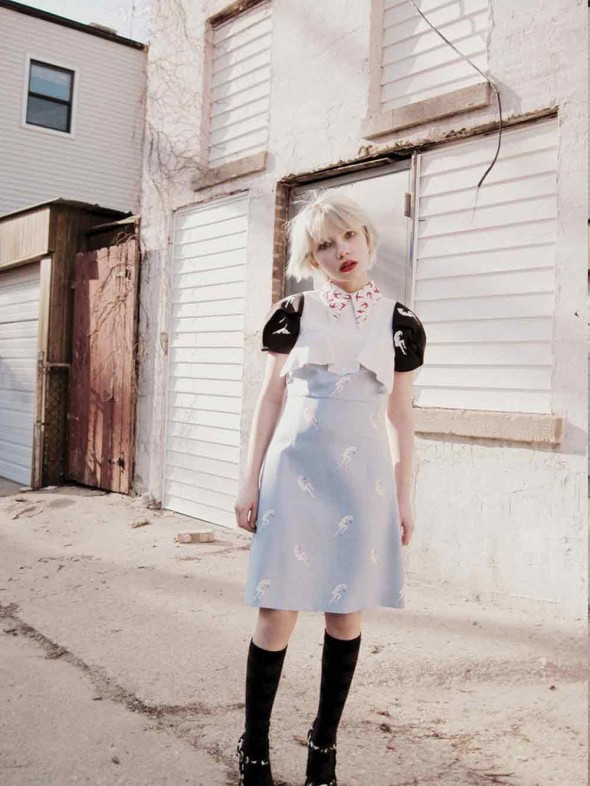
14-year-old Tavi Gevinson (Style Rookie) is only one of many fashion bloggers who has recently come under fire after the industry’s initial fascination with not only this particularly pint-sized, sartorially adventurous Wunderkind, but with other teen bloggers as well. At the start of their meteoric rise, bloggers’ “hipness quotient” led to invitations to couture shows, event openings and massive “traditional” media coverage. In one news-making blog event, Chanel dressed Jane Aldridge (Sea of Shoes) in couture for the 19th annual Bal Crillon des Debutantes. Photographs of 18-year-old Aldridge in sparkling black-and-white cemented Aldridge’s position as one to be admired, if not downright envied, by her peers.
However, suspicion of this new guard of fashionistas erupted rapidly in the following year. Perhaps it was Tavi’s front-row appearances at January’s Paris Fashion Week, which aroused the ire of many fashion veterans. For instance, Simon Doonan, Creative Director at Barneys said in GQ, “…The shows this season were full of teen/tween bloggers. I feel like they are trying to nudge me out of my front-row seat.” Perhaps it was Rumi Neely’s apparel designs/modeling for RVCA, or Aldridge’s line of shoes for Urban Outfitters. Whatever the trigger, or series of triggers, suspicion over the so-called “democratization” of fashion, as academic and Threadbared blogger Minh-Ha T. Pham calls it – an ideal in which anyone, anywhere, could become a part of the cultural conversation with the aid of a computer – aroused questions about bloggers’ qualifications to influence that very industry outside of the Internet.
There is also the matter of taste and age. An enormous percentage of “star bloggers,” and particularly ones who gain a large amount of print press, are in their teens or twenties—placing them in an unusual position when compared to more established fashion journalists. As Huffington Post’s style editor, Lesley M. M. Blume, said in New York magazine regarding Gevinson’s debut Harper’s Bazaar column, “I think it was insulting enough when we were expected as adult women to take our fashion cues from Mary-Kate and Ashley Olsen.” Mary-Kate Olsen’s “bag lady” style, for example, has been hailed as avant-garde but fairly inimitable, whereas Ashley Olsen’s pet project, The Row, has been snapped up and lauded by the likes of Lauren Hutton and Gwyneth Paltrow. Derision escalated when Racked.com jokingly sent a 5-year-old fashion blogger to New York Fashion Week; though Katie’s presence was intended as parody, droves of angry fashionistas tackled Racked.com with comments clamoring for “adult” fashion commentary.
But perhaps more important to the bloggers themselves are suspicions regarding their developing ethics, or lack thereof. Many fashion bloggers see monetization and other “perks” as a positive side effect of their love for fashion, and the tantalizing possibility of being showered by free goods, becoming friends with famous designers, and having their photograph taken by a publication like Vogue, is hard to resist. Producing a written and visual product, after all, can be seen as the Internet equivalent of print media providing the same service, and therefore earning the same sorts of advertising, attention, and free product. Yet U.K.’s The Independent claims that “senior fashion insiders believe blogs have turned into little more than mouthpieces for fashion brands,” and quotes Dolly Jones, editor of Vogue.com, as stating that “PR’s plant stories with certain bloggers… [as] a really powerful selling tool.” Late last year, the Federal Trade Commission provided “Final Guides Governing Endorsements [and] Testimonials,” causing the bulletin boards on the Independent Fashion Bloggers Website to buzz with discussion about what, exactly, all of the legalities meant for fashion bloggers, who are often bombarded with emails about whether or not they wish to receive free product.
As with any developing industry, new boundaries and guidelines are still being set, and though the self-imposed rules alongside the FTC’s vary from blogger to blogger, panels at places such as the February Chictopia10 Social Influence Summit allowed bloggers such as Rebecca Stice (The Clothes Horse) and Judy Aldridge (Atlantis Home and mother of Jane Aldridge) to voice their opinions about how best to work with sponsors and companies in general. At that particular panel, Stice said, “You might have to say, ‘If I don’t like the product that you send me, I might have to post a negative review…’ Have a standard that you’re willing to stick by and you also have to be willing to lose [the sponsor]. You have to be willing to let it go if it doesn’t go smoothly, because you can’t really sacrifice [quality], because it will really ruin your blog, overall.” And a bad blog is not good for fashion, no matter what generation you’re from.
– Meggy Wang

